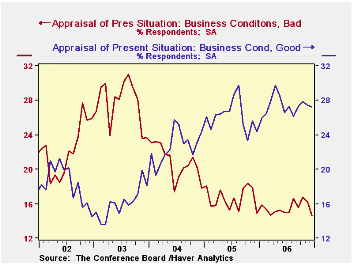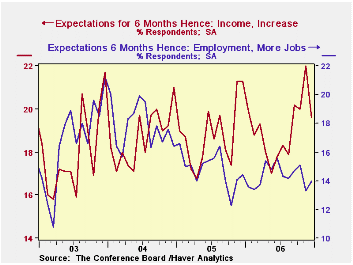 Global| Dec 28 2006
Global| Dec 28 2006Consumer Confidence Increases Unexpectedly in December, but Net Gains Based in Fewer Negative Responses
Summary
Consumer confidence rose in December, according to the Conference Board's monthly survey. It went up 3.7 points to 109.0 (1985=100), the highest reading since April. November's figure was revised upward by 2.3% from 102.9 reported a [...]

Consumer confidence rose in December, according to the Conference Board's monthly survey. It went up 3.7 points to 109.0 (1985=100), the highest reading since April. November's figure was revised upward by 2.3% from 102.9 reported a month ago. Both major components, assessments of present conditions and expectations for the coming six months, contributed to December's rise, adding 4.5 points and 3.2 points, respectively. This outcome differs from the University of Michigan survey, which eroded a bit on diminished expectations. It also differs from consensus forecasts, which had looked for a decrease from the original 102.9 to 102.1.
"Present conditions" are measured by responses about general business conditions and the status of labor markets. This month, ironically, fewer consumers said they see business conditions as "good", but the number saying they are "bad" decreased more. There appears to be some improvement in the availability of jobs, as the number seeing jobs as "plentiful" increased 1.2 points, although at 26.9%, that remains below the first seven months of 2006. The proportion of consumers believing jobs are "hard to get" also rose a bit, but just 0.9 point; this too has a less favorable reading than what prevailed in the first half of 2006.
Expectations are mixed. The share of consumers looking for "more jobs" increased 0.7 point to 14.0%, but paradoxically the share expecting their income to go up decreased by 2.4 points. Sources of the rise in expectations are actually more "back-handed": fewer people expect business and employment conditions to worsen.
So, despite the favorable appearance of the overall consumer confidence indexes, the details suggest that people remain skittish. Results concerning interest rates and the stock market also indicate this ambivalence: while many fewer people are looking for higher interest rates, the number of people looking for higher stock prices is down and the number looking for lower stock prices is up. Stay tuned!
| Conference Board (SA, 1985=100) |
Dec 2006 | Nov 2006 | Oct 2006 | Dec 2005 | 2006 | 2005 | 2004 |
|---|---|---|---|---|---|---|---|
| Consumer Confidence Index | 109.0 | 105.3 | 105.1 | 103.8 | 105.8 | 100.3 | 96.1 |
| Present Conditions | 129.9 | 125.4 | 125.1 | 120.7 | 130.1 | 116.1 | 94.9 |
| Expectations | 95.1 | 91.9 | 91.9 | 92.6 | 89.6 | 89.7 | 96.9 |
Carol Stone, CBE
AuthorMore in Author Profile »Carol Stone, CBE came to Haver Analytics in 2003 following more than 35 years as a financial market economist at major Wall Street financial institutions, most especially Merrill Lynch and Nomura Securities. She has broad experience in analysis and forecasting of flow-of-funds accounts, the federal budget and Federal Reserve operations. At Nomura Securites, among other duties, she developed various indicator forecasting tools and edited a daily global publication produced in London and New York for readers in Tokyo. At Haver Analytics, Carol is a member of the Research Department, aiding database managers with research and documentation efforts, as well as posting commentary on select economic reports. In addition, she conducts Ways-of-the-World, a blog on economic issues for an Episcopal-Church-affiliated website, The Geranium Farm. During her career, Carol served as an officer of the Money Marketeers and the Downtown Economists Club. She has a PhD from NYU's Stern School of Business. She lives in Brooklyn, New York, and has a weekend home on Long Island.





